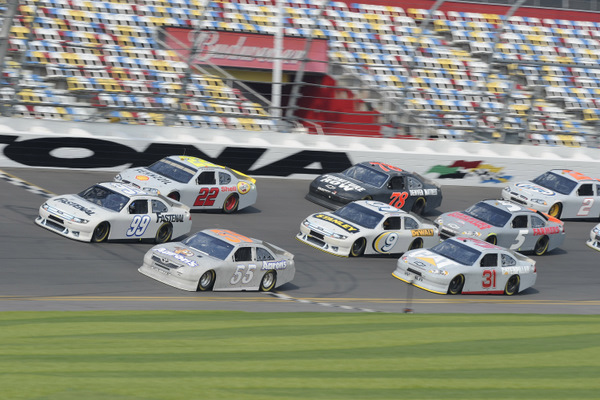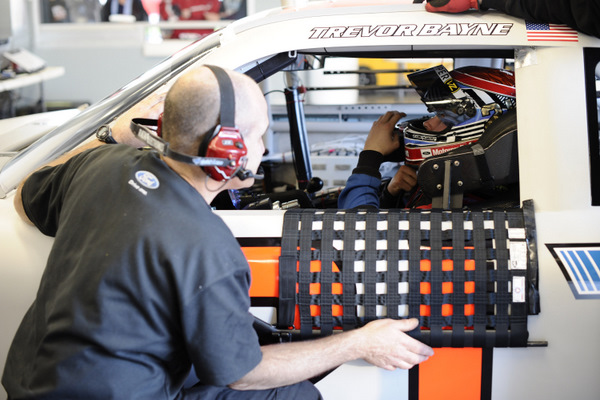Daytona 500 game time looming...and the rules? Hey, why keep tweaking? Just let 'em race

Carl Edwards (99) and Michael Waltrip (55) lead a big pack during Daytona testing. But how much just for show? Who's really got what? And how will the Daytona 500 itself really shake out? (Photo: Getty Images for NASCAR)
By Mike Mulhern
mikemulhern.net
NASCAR teams just wound up three days of hard testing, with daily rules tweaking, and the verdict?
That probably won't really come till Saturday Feb. 18th, during the kickoff Bud Shootout.
A ever-present flaw in preseason testing is that teams aren't going to show NASCAR officials what all they've learned, what all they've got up their sleeves for the sport's biggest race.
And, as became clear at Talladega last fall, when some rules tweaks, in the wake of the July Daytona 400, fell far short of what the sanctioning body anticipated.
Too, the whole two-car thing, as it unfolded at Daytona one year ago, was seemingly a big surprise to many in the sport...though not the crew chiefs and drivers, who planned for it.
So will officials be ahead of the curve this time? Or is NASCAR again making new rules for the last plate race rather than new rules for the next plate race?
Then again, why keep messing with the rules anyway. These teams typically do a very good job of policing themselves. Why officials keep interjecting themselves in the process sometimes seems misguided and unnecessary.
Just let things unfold as they will.

Remember Trevor Bayne? (Photo: Getty Images for NASCAR)
But then, remember, this is not all about necessarily trying to change the shape of Daytona racing, but rather trying to put an element of surprise into the pre-race marketing package.
Remember too that NASCAR holds over drivers that threat of secret penalties and fines if drivers say anything the sanctioning body doesn't like.
Brad Keselowski was the most recent driver hit with one of those heavy-handed penalties, for his outspoken complaints about the economic and technological efficacy of the changeover from venerable carburetors to more modern electronic fuel injection.
The Daytona storyline is this:
In the face of complaints by fans about the novel, intriguing but apparently disconcerting two-car drafting that was the feature of last season's four restrictor plate events at Daytona and Talladega, NASCAR's John Darby, Robin Pemberton and Mike Helton have worked feverishly to eliminate the considerable edge in speed two-car drafters have had over the big pack.
Darby and Pemberton say they're pleased with what they've seen, during the three days of rules tweaking. "Everything we've done has all been in the correct direction," Darby says. "Short of nailing down some final sizes of grille openings and radiator pressures and things of that nature, I think we're there.
"I think we're very close."
NASCAR's Robin Pemberton: Once a star crew chief, now the man with the rule book (Photo: Getty Images for NASCAR)
Last season that smooth, grippy new asphalt changed up things dramatically. Two-car packs ruled, because two cars hooked together are faster and more aerodynamically efficient than any other combination.
Some teams tried four-car packs, but that didn't work.
Two cars ruled.
And there was some great, if unpredictable, racing, and dicey finishes.
Jeff Gordon: "Pretty much every race I've won (at Daytona) was won in a type of drafting style where you had to plan to pass and work yourself into position every single lap; and it took several laps to try to make a pass on the car, whether they were the lead car or fifth place.
"These days the shuffling just goes back and forth, back and forth, and it seems like the passing and getting passed is easy in some ways, and it's really as much about timing and luck as it is about planning it."
Indeed the biggest downside to the two-car thing seems to be that it's hard to watch a race and see what's developing, because the closing rate of a two-car pack can be flat amazing. Two guys can blast from the back to the front almost like magic, seemingly with more luck than rhyme or reason.
So NASCAR, listening to complaints from fans who prefer big pack racing, seems determined to try to kill the two-car draft, or at least diminish its edge.
Now this looks interesting: Sprint Cup rookie Danica Patrick, getting a big push from teammate/boss Tony Stewart (Photo: Getty Images for NASCAR)
Part of the problem with the two-car draft, however, may really stem from the inability of TV to adequately explain and analyze it in real-time. For those watching closely the two-car packs, with those amazing bursts of speed, have been awe-inspiring.
NASCAR's Robin Pemberton, once a star crew chief himself, at the closing of Saturday's final round of testing, said "We've been shrinking plates, growing plates and working on different parts of the cooling system, and the goal was to see what our limits were."
And Darby points out that teams these days are well aware that NASCAR may change things quickly and are thus prepared for most of those changes.
Pemberton, reflecting on his days as a crew chief at Daytona, says "You would want, as early as you could, to have the rules just locked down, so you can work on your package.
"In today's world they know that's unrealistic. The whole mindset is different nowadays.
"Back in 'the day' you would build your best car, you'd come down and hope nobody would even come look at your car. You just wanted to be on your own and hide what you could hide, and work what you could work with and get your advantages.
"But that was then, and in today's world I don't think the mindset is near the same."
Daytona testing...and any verdict? (Photo: Getty Images for NASCAR)
So expect more tweaks before race day.
Good or bad?
Why not just let 'em race and see how it goes?
And then there's the rule of unintended consequences here, and NASCAR's tweaking -- drag versus rpm, and all -- during testing changed the effective engine power band. Which manufacturer that might benefit is up in the air.
When NASCAR opened up the plates for Friday's runs, speeds went up, but so did rpm, and engine men said they were worried.
Jack Roush: "We still don't know exactly what is going to happen. Right now our Ford engines are only good for about 9100 rpm, and it looks like we need 9500 to make it work. So that sends us back to work on it...unless they change the (rear end) gear rule.
"I have to find out what I should be working on. If the gear rules go open, then we know to leave the engine alone. If they bring the (rev limiting) chip and-or keep us with the gears we've got, then we've got a lot of work to do on the engine."
NASCAR responded by switching back to a smaller plate.
Darby: "With the (smaller) plate on, we're still going to have the excitement of seeing some race speeds over 200 mph. But at the same time we've been able to take all the engine builders off suicide watch. They're in a much more comfortable place.
"The rpm are back to what I'm going to call reasonable, and everything is performing very well right now."
Better watch these two. And Jimmie Johnson (L) may owe teammate Dale Earnhardt Jr. a push, for his help in winning Talladega last year (Photo: Getty Images for NASCAR)
There is still question whether any of this may really work.
"NASCAR has seemed pretty determined to break up the two-car thing," Roush says. "But as long as the tire is as good as it is, and the cars have as much downforce as they do, and the cars handle really good and you don't really upset the car when you get together (in a two-car pack), then it becomes if you wind up controlling them by making the engines so they can't operate in a range when they push like that. Or do they come back and do it with the cooling system...
"They've got one of those things to work with, and my guess is there will be some serious compromise -- based on the fact that someone is going to complain that their hardware is not right for the rules they are given."
Edwards, who pushed Trevor Bayne to victory at Daytona a year ago, says "there is a lot on the table right now" for NASCAR to tweak.
"If the cars were either just a little faster or had a little less grip, then we would get to that old Daytona feel, where you would get in the corner and have to lift a little.
"There are a lot of things being discussed -- rpm, plate size, rev limiters, downforce...I am glad NASCAR is trying all this stuff to let us see what may happen.
"(But) I don't envy NASCAR's position."
Water temperature (and water pressure) is one part of the technological game. Ford's new FR9 engine has shown superior cooling, a plus when running second in a two-car draft. But rivals developed their own cooling tricks last year, and NASCAR's tweaking of water pressure relief valve limits may not be very effective any more. Teams have done everything from putting grease on their front bumper to off-setting the nose to improve air flow and make the two-car thing work.
The water temperature/pressure war was almost amusing to observers last season. The issue was -- and apparently is -- how long a particular driver could run behind his teammate/leader in a two-car pack, without his engine temperature getting too hot.
And then 'how hot is too hot?' Can you run for three laps at 280 degrees? Ten laps at 250 degrees?
Making a swap in a two-car draft hurts speed considerably, so staying tucked together tight is critical in keeping speed.
Bottom line in all this?
Carl Edwards: "Two cars, unless there is some major change in physics or car design, are going to be faster.
"...unless you make it so you have to slow down for the corner, or you limit the rpm.
"I personally would prefer them to make the cars drive where you have to lift for the corner in that two-car draft. It would separate the cars and keep guys from running off."
Edwards' conclusion:
"I don't know how you are going to take this race, with this restrictor plate, and keep it from being the winner wins by being in a two-car draft."
Let's see, now who's in which car this season? (Photo: Getty Images for NASCAR)
© 2010-2011 www.mikemulhern.net All rights reserved.
Web site by www.webdesigncarolinas.com







Post new comment